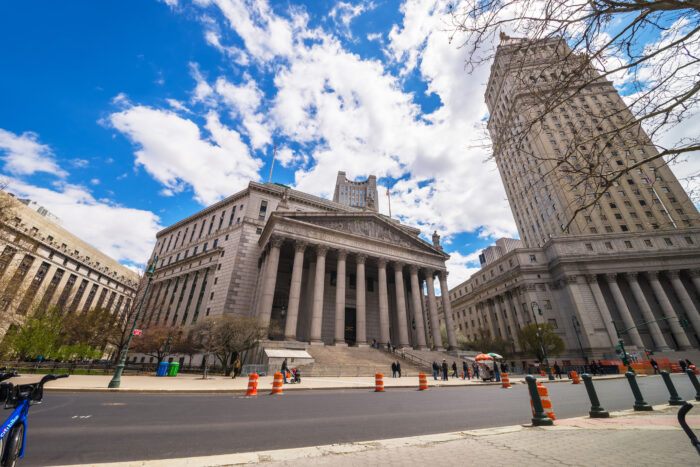Confessions of a Grand Jury Foreperson

Thurgood Marshall Criminal Court Building Lower Manhattan iStock photo Getty Images
Spoiler Alert. This Monthly Insight has little to do with economics or investing.
I do include numbers though.
This story is about my experience serving on a Grand Jury in New York City as the randomly selected Foreperson.
Memories of my time served on a grand jury haunted me as one prominent person was recently indicted on thirty-four felony counts by a New York Grand Jury.
As the public focused on the person indicted, I was fascinated with the number of felony counts. Thirty-Four is a Big number.
I’ll explain.
Most people are familiar with trial juries. Both the defense attorney and the prosecuting attorney ask potential jurors questions. The courtroom is crowded with people, the judge, the defendant, the witnesses, the bailiff , the court stenographer, journalists, artists. It is a scene. Emotions run high.
Guilty or Not Guilty? We are endlessly fascinated with jury trials.
A grand jury is much more sedate. The purpose of a grand jury is to determine if the evidence presented by a prosecutor provides probable cause to issue an indictment.
An indictment allows the prosecutor to move forward with the case.
Members of a grand jury, after hearing the evidence, vote either to issue an indictment, or not. That is it.
Sometimes there are witnesses. Rarely does the defendant make an appearance. I don’t think I knew the name of any defendant.
There is no judge present.
In fact, deliberations of a grand jury are secret.
There are twenty-three members of a grand jury. Sixteen members must be present to take a vote. Twelve votes are for an indictment.
When I received notice that I had to serve on a Grand Jury, the first thing I learned is that excuses are not allowed. Seriously, no way. I could choose another date within a six-month range but that’s it. I chose August. Hot and humid in New York City but I thought so many people leave the city during August it could be a low crime month.
My grand jury service was daily for a month.
This is what happened.
I showed up at the same courthouse (pictured above) in lower Manhattan as that well-known person recently did . When I arrived I found about two hundred other people all of whom were being “seated” in different grand juries.
After receiving instructions from the judge about our duties, the process for selecting the foreperson began. There was a big tumbler at the front of the room. Everyone’s name was in the tumbler. The tumbler was given a big spin. Names were pulled out and I nearly passed out when I heard my name called.
As we entered the jury room for the first time the bailiff instructed me to sit at an elevated dais at the back of the room. To my right was a randomly chosen Secretary and to my left was a randomly chosen Assistant Foreperson. The rest of the jurors sat in rows arranged in a semi-circle facing forward.
All I could think was that it was clear to anyone who came in as a witness who the Foreperson was. And no, there is no witness protection program for a grand juror.
The prosecutor gave us instruction on the law and the process on day one.
Our job was not to decide innocence or guilt beyond a reasonable doubt. We decided whether the evidence presented was enough to believe that a crime(s) had been committed.
When a grand jury votes to indict, that is the first step in what could be an exceedingly lengthy process, and we had no idea what the eventual outcome would be. The case may never go to trial, the judge could throw the case out, there could be a plea bargain, charges could be dismissed, or the case could go to trial. We had no way of knowing.
Over the course of a month, a grand jury hears evidence on multiple cases. In “my” jury we heard evidence on fifty-two different cases.
The day would begin with the bailiff handing me a handwritten slip of paper listing the charges of the first case. The Secretary would record (handwrite) the charges in a noticeably big book.
As we listened to the prosecutor , if we had a question we couldn’t blurt it out. We had to raise our hands, the prosecutor would come over and we had to WHISPER the question in the prosecutor’s ear.
The prosecutor decided if the question should be repeated to the entire jury.
After the first day I thought about how we could make this process easy for all the members of the grand jury, none of whom looked to happy to be there.
On day two, as the foreperson, and before the bailiff or the prosecutor came into the courtroom I asked the members of the grand jury if they would be willing to do the following:
After we hear the evidence, and everyone has the chance to ask questions we immediately take a vote. My thought was that most people would know right away if they thought the evidence was enough to indict. If there were twelve or more votes to indict, we indict and move on. If anyone thought twelve votes was borderline, we could discuss.
But if anyone disagreed with how the person sitting next to them voted, we had to respect that person’s decision.
I have to say there was quite a positive response to this approach . A few people asked me if I was a professional juror. No, just someone who focused on what our job was and how to get through the month of August.
As I mentioned, we heard fifty-two cases. Out of the fifty-two cases we voted to indict on forty-nine.
It was interesting, in the three cases we voted NOT to indict, it was clear to the jurors that the evidence just wasn’t there. I was amazed at how obvious it was.
On a percentage basis, we indicted 94% of the cases we heard.
All voting and discussions done in secret. The prosecutor must leave the room.
Once we finished voting, I filled out the piece of paper, “rang” for the bailiff to take the results and we were on to the next case.
Back to the beginning of this story. Having served on a grand jury I was shocked that the grand jury for the well-known individual returned thirty-four indictments.
In all the fifty-two cases we heard, the typical number of indictments was 5-10.
I thought about all the work, the time, and the evidence needed to get thirty-four indictments.
That seemed unusually high.
I’ve done follow up research on grand jury indictments.
It turns out that grand juries indict 95-99% of the time.
Draw your own conclusions of course, but remember that grand jury indictments are based on evidence and nothing else.

This website is for informational purposes only and does not constitute an offer to sell, a solicitation to buy, or a recommendation for any security, nor does it constitute an offer to provide investment advisory or other services by The Modest Economist LLC.
